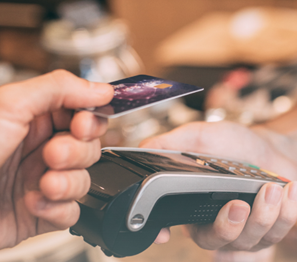
Swipe, tap and thrive: Why every single-location restaurant needs a POS
Learn why a POS system is essential for small quick service restaurants and which features help streamline orders, boost sales, and keep your café running smoothly.

A point-of-sale system (POS) is a foundational business tool to manage transactions, streamline operations and enhance customer experiences. Whether you're running a small retail shop or a bustling restaurant, a POS system acts as the central hub for accepting payments, tracking sales and even managing inventory. It combines software and hardware to handle everything from basic sales processes to advanced analytics, tailored to your business's specific needs.
POS systems are more than just a machine for transactions; they’re like your business’s tech-savvy sidekick, keeping things running smoothly behind the scenes. Modern POS solutions integrate with other tools like accounting software and customer relationship management (CRM) platforms, making them a key asset in improving operational efficiency. Understanding what a point-of-sale system is, how it works and its potential impact is critical when choosing the right solution for your business.
A point-of-sale system is the cornerstone of efficient transaction management. It provides merchants with tools to process sales while seamlessly integrating other key business operations. Its functionality can be divided into distinct processes, each playing a vital role in ensuring smooth day-to-day operations.
At its core, a POS system facilitates transactions by calculating totals, applying taxes and accepting payments. The process begins when a product is scanned or manually entered into the system. Once all items are added, the POS software generates the final amount owed, offering various payment methods such as debit cards, credit cards or mobile wallets. After payment is completed, a receipt is issued—either digitally or as a printout—to confirm the purchase.
A POS system simplifies inventory management by automatically updating stock levels as sales are processed. This feature helps businesses maintain accurate records of available products, track low-stock items and even generate reorder alerts. Real-time tracking reduces the risk of overstocking or running out of popular items, improving operational efficiency and customer satisfaction.
Beyond transactions, POS systems provide valuable insights through detailed reports. These reports analyze sales trends, peak business hours and customer preferences, helping merchants make informed decisions. Metrics such as best-selling products or seasonal performance can be used to refine strategies and identify new growth opportunities.
A well-designed POS system streamlines these processes, saving time and resources while offering actionable insights that empower merchants to focus on growing their businesses.
A point-of-sale system is composed of several key components that work together to manage transactions and support business operations. Each component plays a specific role, ensuring efficiency and reliability in the sales process.
Each component is pivotal in ensuring the POS system is functional, secure and adaptable to various business needs. Whether you’re running a single-location store or managing multiple outlets, understanding these components helps you make informed decisions about the right POS solution.
Different businesses require tailored solutions, and choosing the right type of point of sales system depends on your operational needs, industry and budget. Each type offers unique features and benefits, catering to various use cases.
Each type of POS system offers specific advantages, and understanding these options helps you identify the best fit for your business operations and growth strategy.
Choosing the right POS system is vital for ensuring smooth business operations and delivering excellent customer experiences. Modern POS systems are designed with advanced functionalities to support everything from transactions to business analytics. Here’s an expanded look at the key features to consider:
Efficient sales management is the cornerstone of a POS system. Beyond processing transactions, features like multi-tender payment options, split billing and quick refunds help accommodate diverse customer preferences. Customizable sales reports provide valuable insights into trends, peak sales times and top-performing products. Built-in tools for tax calculations, discounts and tip management ensure transactions remain accurate and streamlined, even during busy periods.
For businesses managing physical products, a robust inventory tracking feature is critical. The ability to track stock in real time, set low-stock alerts and automate reordering ensures you’re never caught off guard by shortages. Advanced systems may also include tools for managing inventory across multiple locations, making it easy to synchronize stock levels and transfers between stores or warehouses.
Effective employee management features in a POS system simplify tracking staff performance, setting schedules and monitoring work hours. User-based access controls ensure that employees can only interact with the system based on their roles, maintaining security while boosting accountability. Some systems also offer sales performance tracking, which can inform incentive programs and training initiatives.
The ability to integrate with other essential business tools is a game-changer. Look for POS systems that connect effortlessly with accounting software, ecommerce platforms, payment gateways and customer loyalty programs. Integration reduces the need for manual data input, ensuring accuracy and saving valuable time. It also enables better coordination across various aspects of your business, from online orders to in-store sales.
A built-in CRM system helps businesses build stronger customer relationships by collecting and analyzing data. Features like purchase history tracking and customer profiles enable personalized experiences and targeted promotions. Loyalty program integration, automated email marketing and feedback collection tools help boost customer retention and enhance overall satisfaction.
Security is paramount in any POS system. Ensure the system complies with Payment Card Industry Data Security Standards (PCI DSS) and employs encryption and tokenization to protect sensitive customer data during transactions. Multi-level authentication, user-specific permissions and audit trails provide additional safeguards, protecting your business from internal and external threats.
A user-friendly interface ensures staff can quickly adapt to the system, reducing training time and potential errors. For growing businesses, the POS should be scalable, allowing you to add features or expand functionality as your needs evolve. Mobile or tablet-based POS options are also worth considering for added flexibility in sales operations.
By prioritizing these features, you can select a POS system that meets your current needs and positions your business for future success. The right system improves efficiency, supports better decision-making and enhances customer experiences, ultimately driving growth.
The cost of a POS system varies based on features, hardware and software. Understanding these expenses helps businesses stay within budget.
Businesses can choose a cost-effective solution tailored to their needs by evaluating these factors.
A point-of-sale system delivers a wide range of benefits that help businesses streamline operations and enhance customer satisfaction. Whether you run a small boutique or a multi-location enterprise, these advantages can significantly improve your daily processes and long-term growth.
Implementing a POS system not only supports smoother operations but also offers tools to elevate customer satisfaction and drive business growth. Its multifaceted advantages make it a vital investment for businesses looking to stay competitive in today’s market.
Choosing the right POS system is essential for streamlining operations and meeting your business’s unique needs. Start by assessing your requirements, such as sales volume, payment methods, inventory management and customer engagement tools. Consider scalability to ensure the system can grow with your business and integration capabilities to connect with existing tools like accounting software or ecommerce platforms. Look for a user-friendly interface to minimize training time and ensure ease of use for staff. Balancing functionality with cost is crucial, so compare features and pricing to select a system that provides the best value for your budget while enhancing efficiency and customer satisfaction.
POS technology is changing, driven by advancements in AI, mobile solutions and customer expectations. Artificial intelligence is enabling more intelligent systems with predictive analytics, personalized marketing and fraud detection. Mobile POS systems are becoming more popular, offering flexibility for businesses to operate anywhere, from pop-up shops to large-scale events. Contactless payments, including mobile wallets and NFC technology, are reshaping customer experiences with faster, more secure transactions. Additionally, cloud-based systems enhance scalability and remote management, making it easier for businesses to adapt to changing demands. As POS technology continues to innovate, businesses can expect more intuitive, efficient and customer-centric systems.
A POS system is more than just a tool for processing transactions—it’s a comprehensive solution that supports business growth, enhances customer experience and improves operational efficiency. By understanding the components, benefits, and trends in POS technology, businesses can make informed decisions to select systems tailored to their needs.
A point-of-sale system combines hardware and software to manage transactions, track inventory and provide valuable insights. It helps businesses streamline operations, improve accuracy and enhance customer satisfaction.
While a cash register only handles basic transactions, a POS system offers advanced features such as inventory management, customer relationship tracking and sales analytics, making it a comprehensive tool for modern businesses.
Modern POS systems integrate seamlessly with tools like accounting software, ecommerce platforms and marketing solutions. Integration improves efficiency and ensures consistent data flow across operations.
Retailers, restaurants and service providers benefit significantly from POS systems. They are especially useful for businesses needing accurate inventory management, customer loyalty tracking or multi-location coordination.
POS systems prioritize data security through encryption, tokenization and compliance with PCI standards. These features protect sensitive information and reduce the risk of fraud during transactions.

Learn why a POS system is essential for small quick service restaurants and which features help streamline orders, boost sales, and keep your café running smoothly.

Discover the best POS systems for small retail businesses. Learn how to streamline inventory, boost sales, and improve customer service with the right POS solution.

Learn what card testing fraud is, how it targets your e-commerce site, and the best practices you can use to detect, block, and prevent attacks before they impact your business.

What is contactless payment and how does contactless payment work? Discover how this technology speeds up transactions and improves customer experience with secure, fast processing. Learn what contactless payment is and how contactless payment works to streamline transactions. Find out how it benefits your business with faster and more secure payments.